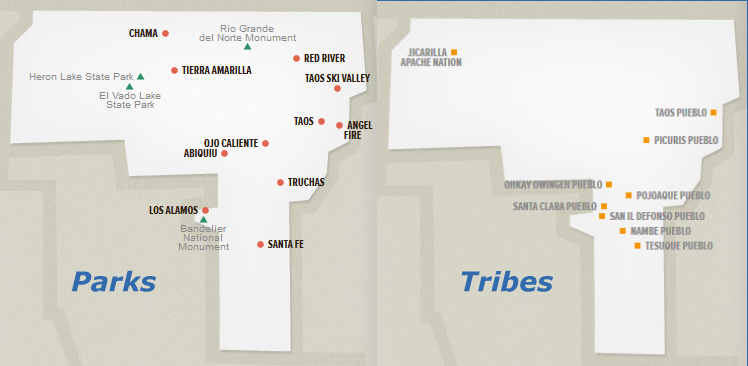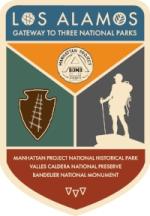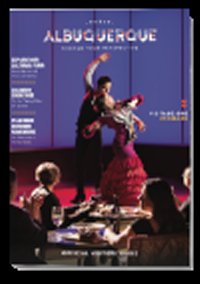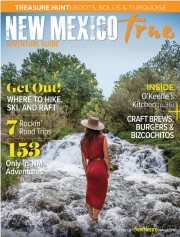
North Central Region Cities, Parks, and Tribes
Welcome to a region we call North to Adventure and Central to Everything. Bring your energy and enthusiasm to enjoy endless recreational activities, art, history, and great cuisine. This is the landscape that inspired Georgia O’Keeffe’s startlingly colorful and shapely paintings. Allow it to do the same to you – ski or snowboard on our powdery snow (Taos Ski Valley, Ski Santa Fe, Angel Fire Resort, Red River, and many others), climb our highest mountain, Wheeler Peak (13,161 feet), or raft through the cavernous Rio Grande Gorge. Hard to miss, it dominates the landscape of the Enchanted Circle (a too-short, very scenic 86-mile drive) between the towns of Taos and Angel Fire. Also hard to miss is Santa Fe, our state’s capital and home to North America’s oldest church and world-renowned art galleries, marketplaces, and performance venues.
The adventure of this region begins in the many mountains that characterize the landscape. Hike, camp, and hunt in the eastern Sangre de Cristo Mountains – (meaning “blood of Christ”) so called because of the red hues they take on at sunrise and sunset – or the northern San Juan Mountains, or the western Jémez Mountains, volcanic in origin and considered sacred and legendary to the people of many pueblos. Here, don your hiking boots and check out Bandelier National Monument, outside of Los Alamos (where the famous Los Alamos National Laboratories are located) and discover 12th-century Ancestral Pueblo cliff dwellings.
If sightseeing is more your interest, you’ll find this region is central to many pueblos, including, Santa Clara, San Ildefonso, San Juan, Jémez, Zia, Tesuque, Pojoaque, and Nambé. Our capital city, so called the “City Different” has all the markings of a cosmopolitan city in its offering of art, culture, and cuisine, but still has a small-town feel. A smaller-town feel can be found north in Taos, gateway to the Enchanted Circle and the Ski Valley, and home to the multistoried Taos Pueblo (continuously inhabited for more than 1,000 years), recently designated a World Heritage Site. And be sure to make a stop in the town of Chimayo to see the early 1800s-shrine, Santuario de Chimayó – the area is famous for its miraculous healing earth and Good Friday pilgrimages.
North Central New Mexico is comprised of four counties and the State Capitol, Sante Fe:
Los Alamos County: The Townsite of Los Alamos and two Pueblos, Santa Clara and San Ildefonso
Rio Arriba County: The City of Española, the Town of Dulce, and the Villages of Chama, Petaca, and Las Tablas
Sante Fe County: Cities are Española and Santa Fe, the Town of Edgewood, and the Nambé Pueblo
Taos County: The Towns of Red River and Taos and the Villages of Questa and Taos Ski Valley

VisitLosAlamos.org
800-444-0707
Nestled in the Jémez Mountains, Los Alamos is the perfect base from which to explore the diverse and transformative history of the region. Three extraordinary national parks are within reach, which, together, offer views into more than a million years of New Mexico’s past. Lovers of history, science, and adventure can explore the worlds of Ancestral Puebloans, 19th-century homesteaders, fearless Rough Riders, and scientists who changed the world.
Bandelier National Monument (part)
Once home to hunter-gatherers and Ancestral Puebloans, Spanish settlers, and, today, intrepid adventurers, Bandelier has trails that wind through cliff dwellings, up rock faces, and along rushing streams. Nightsky programs and guided tours ensure the full experience.
Jemez Mountain Trail
Los Alamos National Lab
Manhattan Project National Historical Park
Preserving the legacy of the 6,000 people who worked on the first atomic bombs, America’s newest park has a guided tour around downtown Los Alamos featuring the places and the people that made up the Secret City. Also worth a visit is the nearby Bradbury Science Museum that offers interactive exhibits exploring the science and engineering of the effort.
Santa Fe National Forest (part)
Rio Arriba County Points of Interest
Abiquiu Lake and Georgia O’Keeffe Tour
Carson National Forest (part)
Cumbres & Toltec Scenic Railroad
Echo amphitheatre
El Camino Real de Tierra Adentro National Historic Trail (part)
El Vado Lake State Park
Ghost Ranch
Heron Lake State Park
Monastery of Christ in the Desert
Juan de Oñate established the first Spanish capital city in New Mexico near Ohkay Owingeh Pueblo (formerly San Juan Pueblo) in 1598. Traditionally, San Juan (O’ke in Tewa) was the center of an Indian meeting ground, its people so powerful that only an O’ke native could declare war for the Pueblo Indians. Although called a Taoseño, Pueblo Revolt leader Popé actually was a San Juan native.
It is one of the largest Tewa-speaking pueblos with a population of about 6,748. Today, the pueblo is the headquarters of the Eight Northern Indian Pueblos Council and home to the Oke-Oweenge Crafts Cooperative, (505) 852-2372, which exhibits the art of the eight northern pueblos. The main art focus of this Tewa village is redware pottery, weaving and painting.
Fishing by permit is available year-round at San Juan Lakes, where many cash fishing tournaments are held, (505) 753-5067. There’s a fee for taking photos or videos or for sketching. Visit Aquino’s Indian Arts and Crafts for samples of woodcarvings and paintings, enjoy a buffet and a round of roulette at the OhKay Casino. (505) 852-4400
Fax: (505) 852-4820
Project Gasbuggy
Puye Cliff Dwellings
Santa Clara Pueblo
Santa Clara Pueblo offers visitors a number of highly diverse attractions, from tours of the pre-historic cliff dwellings of Puye to sightseeing, fishing and camping in the nearby canyon. Because Santa Clara Pueblo has such a large land base, with a wide variety of geographic features , it was possible to make good use of the natural resources for recreational purposes. There are few places in New Mexico that con compare with the majestic beauty of the landscape of the homelands of the Santa Clara people. The splendor of the scenery are justly famous in the Southwest. The Santa Clara Pueblo has emerged with a strong tribal government and a prosperous economy.
Thanks to cultural pride and a strong sense of identity, the Santa Clara people have retained many of their ancient traditions while integrating with the best of what the majority culture has to offer. The Pueblo has a high regard for education, both the tribal heritage and modern education. Santa Clara Pueblo people find employment on the reservation as well as in nearby cities.
Some dances and community festivals are open to the public. In June, St. Anthony’s Feast Day features Comanche Dances. In August, Harvest Dances and Corn Dances are performed in honor of the patron saint, St. Clare. (505) 753-7326
Santa Fe National Forest (part)
Valles Caldera National Preserve (part)
From the blast that created the 13-mile-wide volcanic depression, to the prehistoric farmers and hunters, to the ranchers who have ridden the grasslands for a hundred years, this national park offers ranger programs and guided tours to help visitors see and fully experience this area’s unique high-mountain history.
Sante Fe County Points of Interest
Devils Throne, a landmark near Cerrillos
El Camino Real de Tierra Adentro National Historic Trail (part)
“The Ranch of the Swallows.” This historic ranch, now a living history museum, dates from the early 1700s and was an important paraje or stopping place along the famous Camino Real, the Royal Road from Mexico City to Santa Fe. Experience the life of another time in a location unlike any other in America.
El Santuario de Chimayó
Java Junction, Madrid
Nambé Pueblo
Located 20 miles north of Santa Fe at the base of the Sangre de Cristo Mountains, Nambé means “People of the Round Earth” in the Tewa language, and the pueblo people are from the Tewa ethnic group of Native Americans. The Pueblo of Nambé has existed since the 14th century and was a primary cultural and religious center at the time of the arrival of Spanish colonists in the very early 17th century.
Nambé is known for a distinctive style of pottery, known as Nambé Polychrome. The Feast Day for Nambé Pueblo is October 4. Nambé is a member of the Eight Northern Pueblos.
Nambé Pueblo is a popular stop for visitors seeking beauty and recreation in the stunning foothills of the Sangre de Cristo Mountains. Nambé Falls Recreation Area, (505) 455-2304, located above the pueblo, offers swimming, lake fishing, a stunning double-drop waterfall and camping for a modest fee. The July 4th Nambé Falls Ceremonial, which includes dances and an arts and crafts fair, is a popular festivity for both pueblo dwellers and tourists. On October 4, the pueblo honors San Francisco de Asís, also the patron saint of Santa Fe.
On the way to Nambé Pueblo, stop off at one of the several artist studios and behold Nambé pottery and silver. There’s a fee for photography, sketching or tape/video recording. Guided tours offer a view of the pueblo’s buffalo herd through Buffalo Tours, and young Buffalo Dancers will perform upon advance request. Call for prices and information at (505) 455-2036.
Nuestra Senora de Luz Church, Canoncito
Pecos National Historical Park (part)
Pojoaque was almost destroyed by war and disease, but in the 1930s, survivors returned and fenced off their lands, evicting squatters. Today, about 2,712 people live on pueblo lands. Tribal enterprises include the Cities of Gold Casino, (505) 455-3313, www.citiesofgold.com which features restaurants, shopping, a sports bar and a hotel; for reservations, call (505) 455-0515 or (877) 455-0515.
The Poeh Cultural Center features Pueblo art and exhibits, hosts traditional Indian dances on weekends and preserves the traditional arts of the Tewa-speaking pueblos. It also houses an information center and the largest Indian arts and crafts shop in northern New Mexico. (505) 455-5044. www.poehcenter.com
The pueblo just opened the new Towa Golf Resort for visitors and locals alike. (505) 455-3466, www.towagolf.com
In 2008 the Buffalo Thunder Resort became the largest and mot extravagent resort in New Mexico
In addition to its numerous tribal enterprises, the pueblo has a Wellness Center that houses a gym, library, CHR Program and senior citizens center. The pueblo also opened a boys and girls club for its younger tribal and nontribal members. The Pojoaque Pueblo Tourist Center, (505) 455-3460, displays and sells locally made pottery, rugs, sculpture, kachinas, sand paintings and other souvenirs. The pueblo’s revived feast day is December 12, in honor of Our Lady of Guadalupe. There also are dances on January 6.
San Ildefonso Pueblo
Historians believe the original San Ildefonso people abandoned their original villages at Mesa Verde and Bandelier due to drastic changes in the environment. It was on top of nearby Black Mesa, across the Río Grande from San Ildefonso that the pueblo held off Spanish soldiers during their reconquest of New Mexico in 1694.
Today, the pueblo is a flourishing art community with about 1,500 residents. It was the home of the late Maria Martinez, who along with her husband, Julian, developed the world-renowned, black-on-black pottery with black matte designs. Artisans’ homes throughout the pueblo are open to the public for shopping. The San Ildefonso Pueblo Museum, (505) 455-3549, also displays traditional crafts. With an average of 20,000 visitors each year, San Ildefonso is one of the most visited pueblos in the state.
Permits for non-commercial photography, sketching and recording are available, except during ceremonials, at the visitor’s center (505) 455-3549.
Santa Fe Farmer’ Market, 1607 Paseo de Peralta, near the intersection with S. Guadalupe St.
Santa Fe National Forest (part)
Tesuque Pueblo
Situated in the soft red-brown foothills of the Sangre de Cristo Mountains, Tesuque Pueblo has stood on its present location since 1200 A.D. As such, it is listed on the National Register of Historic Places.
The name Tesuque is a Spanish variation of the Tewa name, Te Tesugeh Oweengeh, meaning the “village of the narrow place of the cottonwood trees.” It is one of the state’s smallest pueblos, with a population of about 800, but the pueblo encompasses more than 17,000 acres, including Aspen Ranch and the Vigil Land Grant high in the Santa Fe National Forest near the Santa Fe ski area.
There are many fine artists at Tesuque who create pottery, paintings and sculpture. Silverwork and traditional clothing are also made at the pueblo.
Tesuque Pueblo operates Camel Rock Casino, (800) 462-2635, (505) 984-8414,www.camelrockcasino.com, the Tesuque Pueblo Flea Market (505) 670-2599 on Opera Hill, just off U.S. 84/285 north of Santa Fe, with vendor booths every weekend from February to December, and Camel Rock Suites, 3007 S. St. Francis Dr. in Santa Fe, (877) 989-3600 or (505) 989-3600.
Tesuque Pueblo is located about 10 miles (16 km.) north of Santa Fe off U.S. 84-285. Entrances to the pueblo lie near Camel Rock, a natural sandstone formation that wind and rain have eroded into the shape of a camel. The pueblo is closed to the public on certain days of the year so call ahead before visiting. Photography is not allowed.
Address: Rt. 42 Box 360-T, Santa Fe, 87506; (505) 983-2667.
Tesuque Flea Market – not your typical flea market
15 Flea Market Road,
Santa Fe, NM 87506
Phone: (505) 670-2599 or (505) 231-8536
www.pueblooftesuquefleamarket.com
We have vendors from all over the world as well as a unique food court serving great food!
Flea Market 2012 Season Hours
March – December 9am – 4pm Friday, Saturday, Sunday
GENERAL INFORMATION:
The pueblo is closed to the public on certain days of the year so call ahead before visiting. Photography is not allowed.
Taos County Points of Interest
Taos is every bit New Mexico, or maybe New Mexico is every bit Taos. There’s the vistas, the food, the people, and the traditions—but with a twist. Locals call it Taos Time: Everything is a little slower and more relaxed. Not surprisingly, summertime visitors reap its benefits, experiencing adventure, culture, and the great outdoors at their own pace.
Carson National Forest (part)
Enchanted Circle (Taos to Angel Fire)
High Road to Taos Scenic Byway (from Sante Fe to Taos)
Las Trampas
Picuris Pueblo
Picurís was once one of the largest Tiwa pueblos, but today it is one of the smallest with about 1,801 inhabitants . Spanish colonizer Juan de Oñate originally named the pueblo Pikuria—those who paint. Like those at Taos Pueblo, the people of Picurís were influenced by Plains Indian culture, particularly the Apaches. Over the past eight years tribal members have restored by hand the 200-year-old adobe church, San Lorenzo de Picurís, located in the center of the pueblo.
The pueblo’s annual San Lorenzo Feast Day on August 10 includes Indian dances, pole climbing and a morning footrace. The High Country Tri-Cultural Arts & Crafts Fair is usually held on the first weekend in June but call to verify (575) 587-2519. The fair features pottery, painting, beadwork, jewelry, weavings and more.
The Picurís Pueblo Museum displays and sells beadwork, weaving and pottery crafted by local artists. Picurís is also the majority owner of the Hotel Santa Fe located in the capital’s historic downtown area.
Trout fishing is available at the pueblo at the Pu-na Lake; call the Picurís Pueblo Fish & Game and Parks & Wildlife, (575) 587-1601. Self-guided tours to excavated structures are available, as are camera permits.
Directions:
The pueblo is located 24 miles southeast of Taos via NM 68, 518, and 75
Plaza of Costilla
Rio Grande del Norte National Monument
Rio Grande Route to Taos
Taos Pueblo, also known as the place of the red willows, sits at the base of the Sangre de Cristo Mountains. The village, which is one of the oldest continuously inhabited communities in North America, was designated a World Heritage Site and a National Historic Site in 1992. The adobe, multi-storied homes of Taos Pueblo have captivated painters and photographers since the 1920s, when an artist colony formed in nearby Taos and virtually established Southwest art. It helped inspire the Pueblo Revival style of architecture in contemporary New Mexico.
The pueblo is home to nearly 4,500 people who value their privacy and insist visitors do the same. Signs mark houses around the plaza that sell arts and crafts. Respect the off-limits signs and don’t climb the ladders to the rooftops.
The Taos people are very skilled in leatherwork, evident in the drums and moccasins they make.
The pueblo operates Taos Mountain Casino, (575) 737-0777, (888) 946-8267,www.taosmountaincasino.com.
The pueblo is located 2.6 miles (4.2 km.) north of the Taos Plaza and is open to visitors most of the year, but closes every spring for eight weeks for ceremonial purposes, so please call ahead. The pueblo levies admission, parking and photography and videography fees. Any sketching, painting or commercial photography requires advance written approval. Photographs and recording are prohibited at religious ceremonies.
Respect the off-limits signs and don’t climb the ladders to the rooftops.
Alcohol is not allowed on the reservation.
The Pueblo is open daily to visitors most of the year, but closes every early spring for eight weeks, so please call ahead.
Fees
The pueblo charges admission, parking and camera fees. Admission: $10 adults and groups (three or more adults) $8, students (13-college) $5, children under 12 free. Photography: still camera $5, video $5. Any sketching, painting or commercial photography requires advance written approval.
Directions:
Taos Pueblo is located 2.5 miles north of the Taos Plaza.
Wheeler Peak


